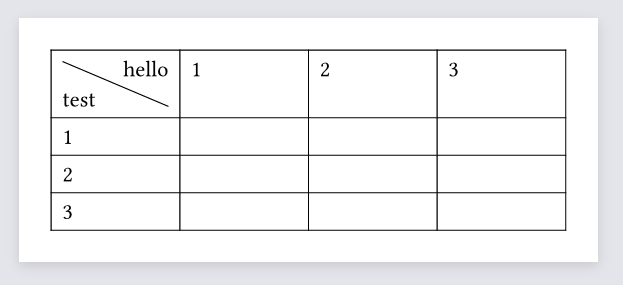I’m trying to name the category’s of my table headers in one cell that its split in two. How could I make it looks like in the image (I manage to do it but have to custom align it)

I’m trying to name the category’s of my table headers in one cell that its split in two. How could I make it looks like in the image (I manage to do it but have to custom align it)

I’d imagine there are a lot of different ways to solve this, so here is one way to solve it:
#set page(width: auto, height: auto, margin: 5mm)
#let diagonal(body-r, body-l, width: auto, height: auto) = {
box(
width: width,
height: height)[
#place(top+right,body-r)
#place(bottom+left,body-l)
#line(start: (0%,0%),end: (100%,100%),stroke: 0.5pt)
]
}
#table(stroke: 0.5pt, columns: 4 * (2cm,),
diagonal([hello],[test], width: auto, height: 2em),
[1],[2],[3],
[1],[ ],[ ],[ ],
[2],[ ],[ ],[ ],
[3]
)

The function #diagonal takes four arguments, the first two are the contents themselves and the other is sizing (width and height). The contents are placed into a box via two #place-functions and a diagonal line is drawn from top left to bottom right.
Is this a perfect solution?
No, one thing it does not consider is the line itself. Content does not wrap inside their triangle space and therefore must be done manually. If no width and height is set, the sizes are inherited from parent components, meaning if it is used outside of box, block or other similar components, it will use the document’s page size!
My solution does not change the table cell’s inset to fully connect the line to the corner. If you want to fill the diagonal line completely, use following code:
#show table: set text(0.9em)
#set page(width: auto, height: auto, margin: 5mm)
#let diagonal(body1, body2, width: auto, height: auto, inset: 5pt) = {
table.cell(inset: 0pt,
box(
width: width,
height: height)[
#place(top+right,body1, dx: -inset, dy: inset)
#place(bottom+left,body2, dx: inset, dy: -inset)
#line(start: (0%,0%),end: (100%,100%),stroke: 0.5pt)
])
}
#table(stroke: 0.5pt, columns: 4 * (2cm,),
diagonal([hello],[test], width: auto, height: 1cm),[1],[2],[3],[1],[],[],[],[2],[],[],[],[3])
This unfortunately limits the function’s use to tables only!
By default, the contents of the diagonal box are inset by the table’s default: 5pt. This can be changed by assigning a length to inset.
That’s what was happening to me to, seems like there’s no perfect solution. That you very much for help.
For now, there is also this package: GitHub - PgBiel/typst-diagbox: A library for diagonal line dividers in Typst tables